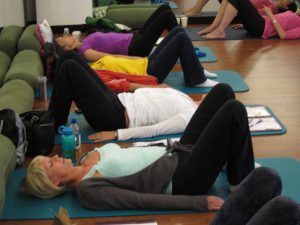Using the breath as a warm up before exercising has many benefits. Breath work can create focus, calmness and relaxation which can facilitate a deeper muscular connection. We can use the breath for the following:-
• Creating focus. By focusing on the breath we allow the mind to grow quiet.
• Creating relaxation. As we grow still, our bodies will begin to relax.
• Activating the pelvic floor and abdominals. Both the pelvic floor diaphragm and the respiratory diaphragm work with breath.
• Establishing individual body alignment. Without tension we allow our muscles and bones to “drop” into better alignment.

Learning to breathe deeply will reset the body reactors. It will change the over worked sympathetic “flight or fight” system to the parasympathetic “rest and relax” system. Breathing also acts as a “pump” for the lymph system which, on its own, does not have the ability to move waste out of the body relying on movement and breathing to help.
Deep abdominal breathing is such a great stress reducer as well as focusing the mind and calming the nerves. It is wonderful to see the energy change in a class when everyone begins to breathe deeply. It creates such a calm, serene atmosphere and is truly beneficial for those who have run into class after a hectic day.
The muscles and bones involved with breathing include the lungs, the diaphragm, the transversus abdominus, the anterior and posterior serratus and the intercostals (the muscles between the ribs). These muscles have attachments to the ribcage which protects the heart and lungs.
During inhalation the diaphragm contracts and pulls downward. This is mirrored by the pelvic floor diaphragm and the palate diaphragm in the roof of the mouth. It is this mirroring that allows us to stretch and release the pelvic floor muscles on an inhale.
The (breathing) diaphragm relaxes back to its original position on an exhalation. There is a moment between an inhale and exhale where no movement of the diaphragm takes place. This is a rest space. This is the space where relaxation occurs.
The pelvic diaphragm (floor) will also return to normal. If we are to strengthen the pelvic floor, the connection should be made at the end of the exhale when all muscles are back to their resting position. This will create a gentler pull on the PF muscles rather than an aggressive, sometimes violent contraction which does little to work the muscles according to their function.
The ribcage will expand sideways, backwards and forward on the inhale and return to normal on the exhalation unless there is a forced exhalation, in which case, the circle of the lower ribs will be pulled together, engaging the transversus abdominus.
